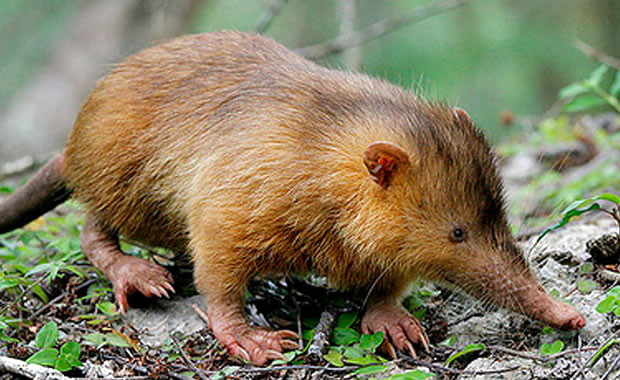

Gray Wolf
|
Creature Profile
The gray wolf is the largest of the canines and can reach a weight of 80 lb and 5 to 6.5 feet in length. It can live for up to 13 years. In the eastern woodlands, the gray wolf is also known as the "timber wolf," and in the arctic, the gray wolf is sometimes called the "arctic wolf." In the tundra, the gray wolf is sometimes called the "tundra wolf." The gray wolf has a gray fur coat with long tawny-colored legs, a narrow chest, and tawny-colored flanks. Males are larger than females. The gray wolf can reach up to 45 mph in a short sprint but can also run up to 25 mph for several miles. They have an excellent sense of smell and hearing.
The gray wolf is an excellent hunter seeking animals and preying on them using their scent. When in packs they can seek large prey, such as moose, elk, bison, or deer. When alone they hunt smaller animals such as hare or beavers. Wolves can travel up to 30 miles a day searching for prey. Wolves are also known for their howling. Wolves howl for several reasons. Howling helps members of the pack keep in touch and to communicate in thick forest area or over great distances. Howling also helps to summon pack members to specific locations, declaration of territory, or claiming of fresh kills.
Wolf packs consists of two parents, their offspring, and a few other non-breeding adults. Females give birth to five or six pups that depend totally on their mother's milk for seven months. After the seven months, they begin hunting with the adult wolves. The pups may remain with the pack for up three years, later leaving to search for their own life-long mates and to try and develop their own packs.
There are an estimated 7000 to 9000 wolves in Alaska and more than 3500 in the lower 48 states. In earlier times there were over 2 million in 57 countries, but now there are only an estimated 200,000. In the 1970s the gray wolf was placed on the endangered species list. The main threat to the survival of the gray wolf was mainly due the hunting and trapping of the wolf because it was thought of as a nuisance and habitat loss due to human encroachment into wolf territories. The gray wolf population was almost completely wiped out, but the gray wolf is now legally protected and is said to be thriving and may even be taken off the endangered species list.
Gray Wolf News/Update - April 20, 2009
Proposed US FWS Delisting of Western Great Lakes DPS population: The gray wolf is listed as endangered with the US Fish & Wildlife Service in Mexico and 48 states in the US. Only the population within the Western Great Lakes DPS is proposed for removal from the federal endangered species list. States within this range are Michigan (upper peninsula), Wisconsin, Illinois (northern), Iowa, South Dakota (eastern), North Dakota (eastern), and Minnesota. As of April 20, 2009, the gray wolf will still hold an endangered status in all remaining states (41) and Mexico.
Wikipedia Article

|
Wikipedia Article Copyright Notice: This article is licensed under the GNU Free Documentation License. It uses material from the Wikipedia article "Gray wolf". |
More Links about the Gray Wolf:
Reference Links:Gray Wolf - Wikipedia
Gray Wolf - New York State Department of Environmental Conservation
Conservation Links:
California Wolf Center
May 9, 2017
Glenn, C. R. 2006. "Earth's Endangered Creatures - Gray Wolf Facts" (Online). Accessed 7/26/2024 at http://earthsendangered.com/profile.asp?sp=937&ID=9.
Need more Gray Wolf facts?





